Maytag MZF34X20DW03, MZF34X16DW04 Owner’s Manual
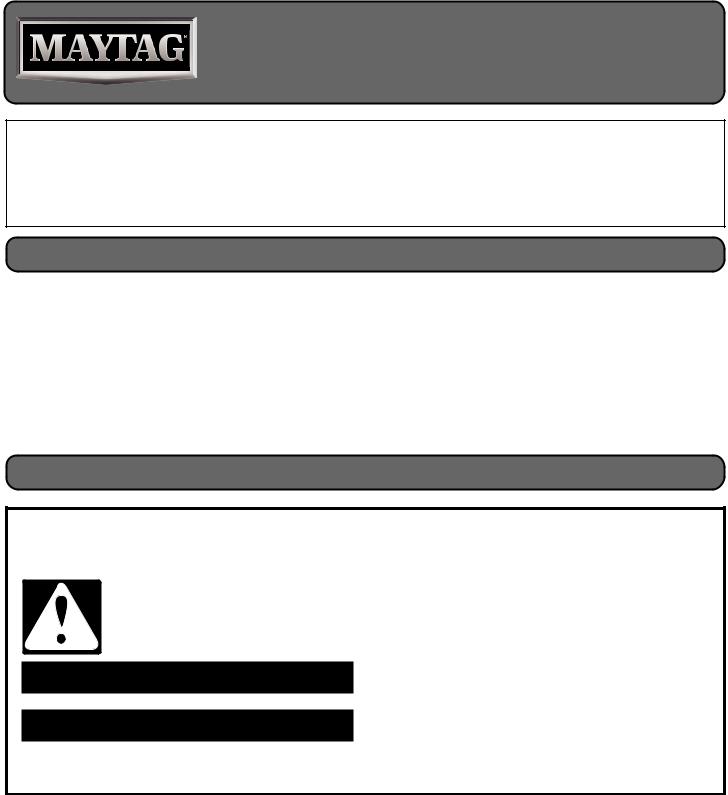
User Guide
Upright Freezer
THANK YOU for purchasing this high-quality product. Register your freezer at www.maytag.com. In Canada, register your freezer at www.maytag.ca.
For future reference, please make a note of your product model and serial numbers. These numbers can be found inside your freezer.
Model Number____________________________________________
Serial Number_____________________________________________
TABLE OF CONTENTS
SAFETY............................................................................................ |
1 |
Using the Control.......................................................................... |
7 |
Proper Disposal of Your Refrigerator or Freezer.......................... |
2 |
Freezer Features........................................................................... |
8 |
INSTALLING YOUR FREEZER....................................................... |
3 |
CARING FOR YOUR FREEZER..................................................... |
8 |
Unpacking..................................................................................... |
3 |
Cleaning Your Freezer................................................................... |
8 |
Location Requirements................................................................. |
3 |
Changing the Light Bulb............................................................... |
9 |
Electrical Requirements................................................................ |
4 |
Power Interruptions...................................................................... |
9 |
Freezer Door................................................................................. |
4 |
Moving Care.................................................................................. |
9 |
Freezer Leveling and Door Closing.............................................. |
6 |
TROUBLESHOOTING................................................................... |
10 |
OPERATING YOUR FREEZER....................................................... |
7 |
Freezer Operation....................................................................... |
10 |
Ensuring Proper Air Circulation.................................................... |
7 |
WARRANTY................................................................................... |
12 |
SAFETY
Your safety and the safety of others are very important.
many important safety messages in this manual and on your appliance. Always read and obey all safety
safety alert symbol.
alerts you to potential hazards that can kill or hurt you and others.
messages will follow the safety alert symbol and either the word “DANGER” or “WARNING.” mean:
 DANGER
DANGER  WARNING
WARNING
You can be killed or seriously injured if you don't immediately follow instructions.
You can be killed or seriously injured if you don't follow instructions.
All safety messages will tell you what the potential hazard is, tell you how to reduce the chance of injury, and tell you what can happen if the instructions are not followed.
W10882915A
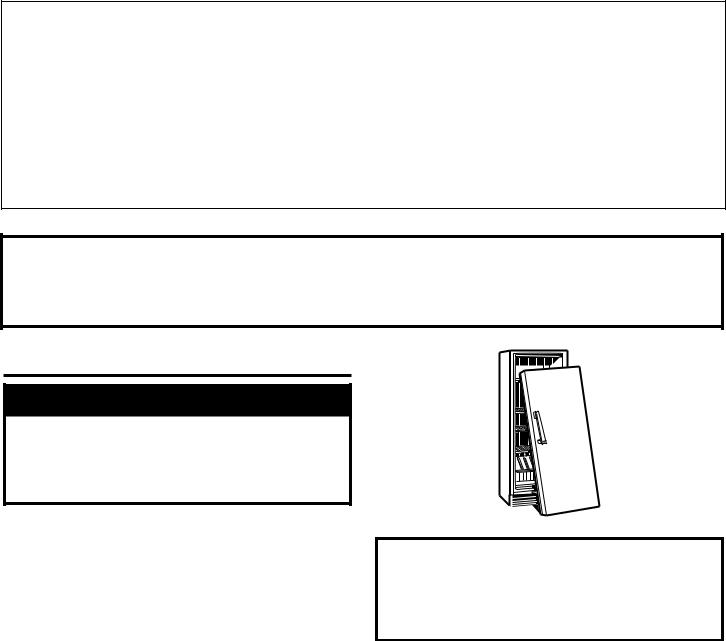
IMPORTANT SAFETY INSTRUCTIONS
WARNING:To reduce the risk of fire, electric shock, or injury when using your freezer, follow these basic precautions:
■Plug into a grounded 3 prong outlet.
■Do not remove ground prong.
■Do not use an adapter.
■Do not use an extension cord.
■Disconnect power before servicing.
■Replace all parts and panels before operating.
■Use nonflammable cleaner.
■Keep flammable materials and vapors, such as gasoline, away from freezer.
■Use two or more people to move and install freezer.
■Keep key away from children.
■Remove doors or lid from your old freezer or refrigerator.
■Disconnect power before installing ice maker (on ice maker kit ready models only).
SAVE THESE INSTRUCTIONS
State of California Proposition 65 Warnings:
WARNING: This product contains one or more chemicals known to the State of California to cause cancer.
WARNING: This product contains one or more chemicals known to the State of California to cause birth defects or other reproductive harm.
Proper Disposal of Your Refrigerator or Freezer
 WARNING
WARNING
Suffocation Hazard
Remove doors or lid from your old freezer or refrigerator.
Failure to do so can result in death or brain damage.
IMPORTANT: Child entrapment and suffocation are not problems of the past. Junked or abandoned freezers or refrigerators are still dangerous — even if they will sit for “just a few days.” If you are getting rid of your old refrigerator or freezer, please follow these instructions to help prevent accidents.
Before You Throw Away Your Old Freezer or Refrigerator:
■■ Take off the doors or lid.
■■ Leave the shelves in place so that children may not easily climb inside.
Important information to know about disposal of refrigerants:
Dispose of freezer in accordance with Federal and Local regulations. Refrigerants must be evacuated by a licensed, EPA certified refrigerant technician in accordance with established procedures.
2

INSTALLING YOUR FREEZER
Unpacking
 WARNING
WARNING
Excessive Weight Hazard
Use two or more people to move and install freezer. Failure to do so can result in back or other injury.
Remove Packaging Materials
■■ Remove tape and glue residue from surfaces before turning on the freezer. Rub a small amount of liquid dish soap over the adhesive with your fingers. Wipe with warm water and dry.
■■ Do not use sharp instruments, rubbing alcohol, flammable fluids, or abrasive cleaners to remove tape or glue. These products can damage the surface of your freezer. For more information, see the “Safety” section.
When Moving Your Freezer:
Your freezer is heavy. When moving the freezer for
cleaning or service, be sure to cover the floor with cardboard or hardboard to avoid floor damage. Always pull the freezer straight out when moving it. Do not wiggle or “walk” the freezer when trying to move it, as floor damage could occur.
Clean Before Using
After you remove all of the packaging materials, clean the inside of your freezer before using it. See the cleaning instructions in the “Caring For Your Freezer” section.
Important information to know about glass shelves and covers:
Do not clean glass shelves or covers with warm water when they are cold. Shelves and covers may break if exposed to sudden temperature changes or impact, such as bumping. Tempered glass is designed to shatter into many small, pebble-size pieces. This is normal. Glass shelves and covers are heavy. Use both hands when removing them to avoid dropping.
Location Requirements
 WARNING
WARNING
Explosion Hazard
Keep flammable materials and vapors, such as gasoline, away from freezer.
Failure to do so can result in death, explosion, or fire.
Ventilation and Clearance
■■ Keep flammable materials and vapors, such as gasoline, away from freezer.
■■ Do not cover the freezer with items such as blankets, sheets, tablecloths, etc. This reduces air circulation.
■■ Allow at least 3" (7.5 cm) of air space at the top and on both sides of the freezer and 1" (2.5 cm) between the back of the freezer and the wall. If the freezer is to be next to a fixed wall, leave extra space on the hinge side so the door can open wider.
Temperature
Your freezer operates most efficiently when located in an area where the temperature will not fall below 40°F (5°C). Place your freezer in a location where the temperature will not fall below this recommended temperature.
Upon Moving to Final Location
NOTE: Allow for a 3" (7.5 cm) clearance at the top and sides and a 1/4" (6.4 mm) clearance between the appliances.
3" (7.5 cm) |
3" (7.5 cm) |
3
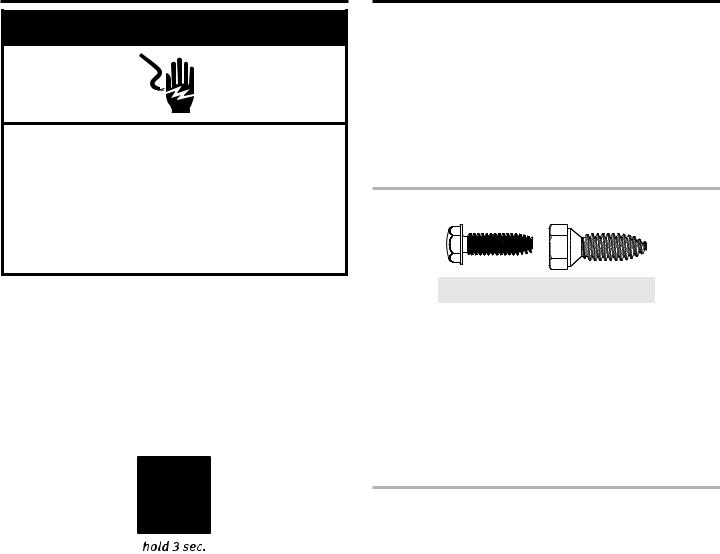
Electrical Requirements
 WARNING
WARNING
Electrical Shock Hazard Plug into a grounded 3 prong outlet. Do not remove ground prong.
Do not use an adapter.
Do not use an extension cord.
Failure to follow these instructions can result in death, fire, or electrical shock.
Before you move your freezer into its final location, it is important to make sure you have the proper electrical connection.
Recommended Grounding Method
A 115-volt, 60 Hz., AC-only, 15or 20-amp fused, grounded electrical supply is required. It is recommended that a separate circuit serving only your freezer be provided. Use an outlet that cannot be turned off by a switch. Do not use an extension cord.
NOTE: Before performing any type of installation, cleaning, or removing a light bulb, press and hold TEMP SETTING for
3 seconds to turn off cooling, and then disconnect the freezer from the electrical source.
Freezer Door
Tools Needed: 5/16" hex-head socket wrench, 3/8" hex-head socket wrench, flat 2" putty knife
IMPORTANT:
■■ All graphics referenced in the following instructions are included later in this section after “Final Steps.” The graphics shown are for a right-hand swing door (hinges factory installed on the right).
■■ If you only want to remove and replace the door, see the “Remove Door and Hinges” and “Replace Door and Hinges.”
■■ Before you begin, press and hold TEMP SETTING for 3 seconds to turn off cooling, and remove food and adjustable door or utility bins from door.
Remove Door and Hinges
Hinge screws
1.Unplug freezer or disconnect power.
2.Keep the freezer door closed until you are ready to lift it free from the cabinet.
NOTE: Provide additional support for the door while the hinges are being moved. Do not depend on the door
magnets to hold the door in place while you are working.
3.Remove the parts for the top hinge as shown in Top Hinge graphic.
4.Lift the freezer door free from the lower hinge and cabinet and set aside.
5.Remove the four hex-head hinge screws and bottom hinge assembly. See “Bottom Hinge” graphic.
Reverse Door (optional on some models)
IMPORTANT: If you want to reverse your door so that it opens in the opposite direction, continue with “Reverse Door (optional on some models)” instructions. If you are not reversing the door, see “Replace Door and Hinges.”
4
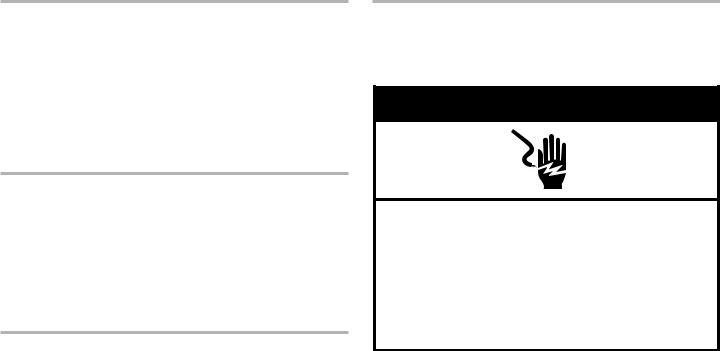
Cabinet
1.Remove the cabinet hinge hole plugs from the cabinet top and move them to the opposite side hinge holes as shown in “Graphic 2.”
2.Remove the bottom hinge pin from the hinge bracket.
3.Remove the decals covering the holes on the opposite side of the bottom hinge.
4.Reinstall the bottom hinge pin in the alternate hole in the hinge bracket. See “Graphic 3.”
5.Reinstall the hinge bracket to the cabinet with the four hexhead hinge screws.
Door
1.Remove the hinge hole plug from the top of the door.
2.Remove the door stop from the bottom of the door.
3.Move the door stop to the opposite side making sure that the hole in the door stop bracket is aligned perfectly with the hole in the door for the bottom hinge pin.
Final Steps
1.Check all holes to make sure that hole plugs and screws are in place. Reinstall top hinge cover. See “Top Hinge” graphic.
2.Using the provided decals, cover the remaining holes located on the side opposite the bottom hinge.
 WARNING
WARNING
Electrical Shock Hazard Plug into a grounded 3 prong outlet. Do not remove ground prong.
Do not use an adapter.
Do not use an extension cord.
Failure to follow these instructions can result in death, fire, or electrical shock.
3.Plug into a grounded 3 prong outlet.
4.Reset the control. See “Using the Control.”
5.Return all removable door parts to door and food to freezer.
5
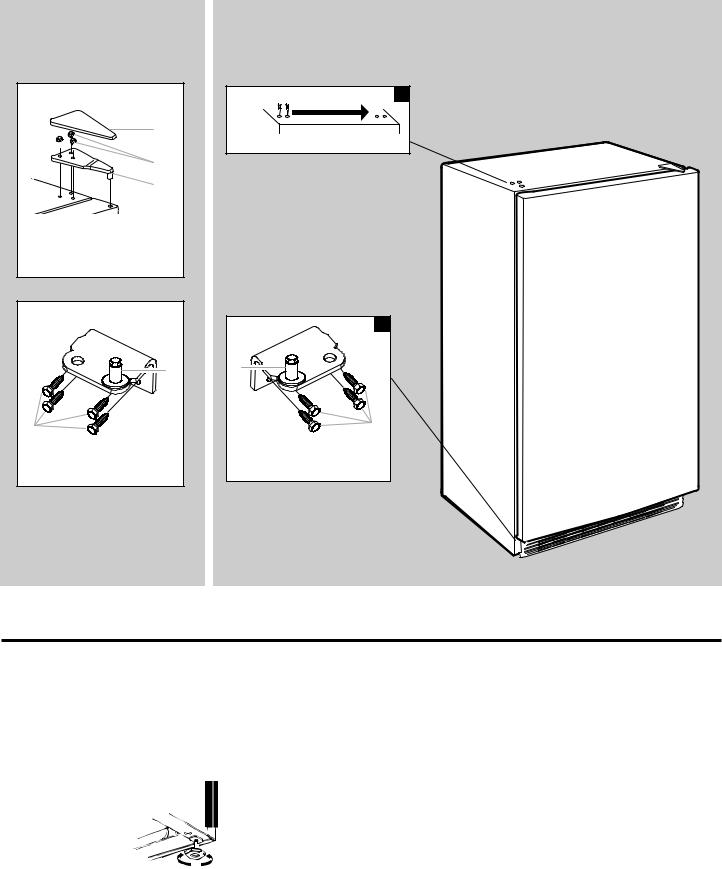
Door Removal &
Replacement
Top Hinge
A
B 


B
C
A.Top Hinge Cover
B.5/16" Hex-Head Hinge Screws
C.Top Hinge
Bottom Hinge |
A |
B |
A. Hinge Pin |
B. 3/8" Hex-Head Hinge Screws |
Door Swing Reversal (optional)
2
A 


A. Cabinet Hinge Hole Plugs
3 |
A |
B |
A. Hinge Pin |
B. 3/8" Hex-Head Hinge Screws |
Freezer Leveling and Door Closing
Style 1—Without Grille
1.Locate the two front leveling legs taped among the packing materials.
2.Screw these legs into the front holes on the bottom of the freezer. The back of the freezer rests on two fixed supports.
3.Adjust the front legs enough to lift the cabinet up off the floor.
4.Place a leveling tool on top of the freezer first side to side, then front to back. Turn leg counterclockwise to raise a corner. Turn leg clockwise to lower a corner.
Style 2—With Grille
Your freezer has two front adjustable legs — one on each side. The back of the freezer rests on two fixed rollers. The base grille covers the adjustable brake feet and roller assemblies located at the bottom of the freezer below the freezer door. Before making any adjustments, remove the base grille and move the freezer to its final location.
Tools Needed: 1/4" hex driver, Phillips screwdriver
1.Remove the base grille screws. Grasp the grille firmly and pull it toward you. Open the freezer door to access the brake feet.
5.Repeat Step 4 until freezer is level.
6.After freezer is fully loaded with food, recheck with level as in Step 4.
6
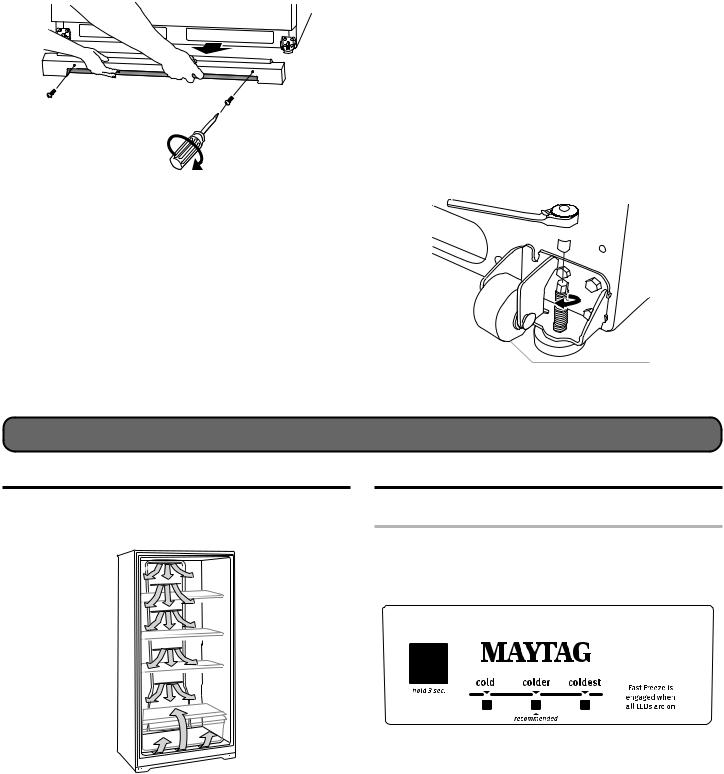
NOTE: To allow the freezer to roll more easily, raise the brake feet by turning them counterclockwise. The front rollers will be touching the floor.
2.Move the freezer to its final location.
3.Lower the brake feet, by turning them clockwise, until the rollers are off the floor and both brake feet are snug against the floor. This keeps the freezer from rolling forward when opening the freezer door.
IMPORTANT: If you need to make further adjustments involving the brake feet, you must turn both brake feet the same amount to keep the freezer level.
4.Make sure the door closes easily. If you are satisfied with the door opening and closing, skip the next section.
If, however, the door does not close easily or the door pops open, adjust the tilt.
5.Make sure the freezer is steady. If the freezer seems unsteady or rolls forward when the door is pulled open, adjust the brake feet.
To Steady the Freezer:
■■ Open the freezer door. Using a 1/4" hex driver, turn both brake feet clockwise the same amount until the brake feet are snug against the floor. Check again. If not satisfied, continue to adjust the brake feet by half turns of the screw until the freezer does not roll forward when the door is opened.
6.Replace the base grille by aligning the ends of the grille with the leveling assemblies on each side and snapping the grille into place. Reinstall the Phillips screws.
To Adjust the Cabinet Tilt:
NOTE: Having someone push against the top of the freezer takes some weight off the brake feet. This makes it easier to turn them.
■■ Open the freezer door. Use a 1/4" hex driver to turn both brake feet clockwise the same amount. This will raise the front of the freezer. It may take several turns to allow the door to close more easily.
 ¹⁄"
¹⁄"
 A
A
B
A.Brake foot
B.Front roller
OPERATING YOUR FREEZER
Ensuring Proper Air Circulation
In order to ensure proper temperature, you need to permit proper airflow in the freezer. As shown in the illustration, cool air enters from the freezer wall and moves down. The air then recirculates through the vent near the bottom.
Do not block any of these vents with food packages. If the vents are blocked, airflow will be restricted and temperature and moisture problems may occur.
IMPORTANT: To avoid odor transfer and drying out of food, wrap or cover foods tightly.
Using the Control
The temperature control is located at the top front of the freezer compartment.
Temperature Control
For your convenience, the temperature control is preset at the factory. When you first install your freezer, check that the control is still set to the recommended setting as shown.
Recommended setting “Colder”
IMPORTANT:
■■ The recommended setting is designed to maintain the temperature at or near 0°F (-17.8°C) under normal operating conditions.
■■ Allow the freezer to cool 6 to 8 hours before filling with frozen food.
7
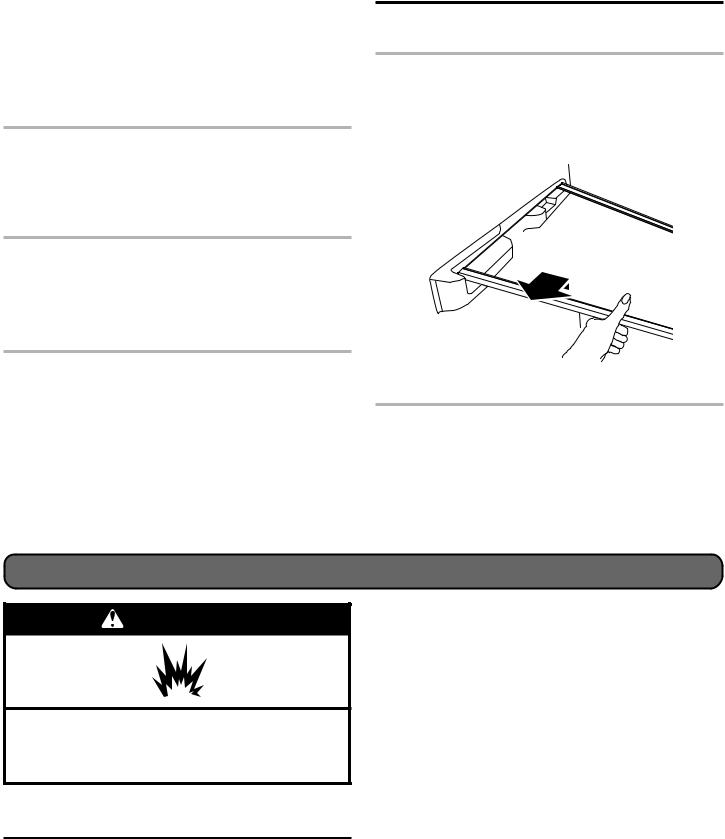
■■ When the freezer is first started, the compressor will run constantly until the freezer is cooled. It may take up to 6 or 8 hours (or longer), depending on room temperature and number of times the freezer door is opened. After the freezer is cooled, the compressor will turn on and off as needed to keep the freezer at the proper temperature.
■■ The outside of your freezer may feel warm. This is normal. The freezer’s design and main function is to remove heat from packages and air space inside the freezer. The heat is transferred to the room air, making the outside of the freezer feel warm.
Adjusting Control
If you need to adjust the temperature in the freezer compartment, press TEMP SETTING to display the desired temperature setting from Cold to Coldest.
NOTE: Except when starting the freezer, do not adjust the control more than one setting at a time. Wait 24 hours between adjustments for the temperature to stabilize.
Cooling On/Off
Your freezer will not cool when cooling is turned off.
To turn cooling off, press and hold TEMP SETTING for 3 seconds. In the off condition, none of the lights on the control panel will be illuminated. The main freezer light bulb will still operate.
To turn cooling on, press and hold TEMP SETTING for 3 seconds. When cooling is on, the control panel lights will be illuminated.
Fast Freeze (on some models)
Use this feature before adding large amounts of unfrozen food. For the best food quality, do not exceed 3 lbs (1,361 g) per cu. ft (28.32 L) of freezer space.
To activate Fast Freeze, press TEMP SETTING until all the indicator light positions are illuminated simultaneously.
The freezer will remain in the Fast Freeze setting for 24 hours after the extra-low temperature is reached. Once the time has expired, the freezer will return to the previous temperature setting. Fast Freeze may be manually turned off by pressing TEMP SETTING to select the desired temperature setting from Cold to Coldest.
Freezer Features
This manual covers several different models. The freezer you have purchased may have some or all of the items listed. The locations of the features may not match those of your model.
Freezer Shelves
Store similar foods together and adjust the shelves to fit different heights. This reduces the time the freezer door is open and saves energy.
To Remove and Replace a Shelf:
1. Remove the shelf by lifting straight up and pulling the shelf out.
2.Replace the shelf by lowering the shelf onto the supports on the side wall.
Storage Gate (on some models)
To Remove the Storage Gate:
1.Lift up the top of the gate and out of the supports.
2.Return the gate to original position. Lower the gate into the supports.
CARING FOR YOUR FREEZER
ARNING
Explosion Hazard Use nonflammable cleaner.
Failure to do so can result in death, explosion, or fire.
Cleaning Your Freezer
Frost-free means that you will not have to defrost your freezer. Frost is removed by air moving and collecting any moisture and depositing it on the cooling coil. The cooling coil periodically warms up enough to melt the frost and it then flows down to the drain pan (located behind the base grille) where it is evaporated.
Complete cleaning should be done at least once a year.
1.Press and hold TEMP SETTING for 3 seconds to turn off cooling.
2.Unplug freezer or disconnect power.
3.Remove all frozen food. Wrap frozen food in several layers of newspaper and cover with a blanket. Food will stay frozen for several hours. You may also store frozen food in a cooler, additional refrigerator-freezer, or in a cool area.
4.Remove all removable parts from inside, such as shelves, bins, etc.
5.Hand-wash, rinse, and dry removable parts and interior surfaces thoroughly. Use a clean sponge or soft cloth and a mild detergent in warm water.
■■ Do not use abrasive or harsh cleaners such as window sprays, scouring cleansers, flammable fluids, cleaning waxes, concentrated detergents, bleaches, or cleansers containing petroleum products on plastic parts, interior and door liners or gaskets. Do not use paper towels, scouring pads, or other harsh cleaning tools. These can scratch or damage materials.
■■ To help remove odors, you can wash interior walls with a mixture of warm water and baking soda (2 tbs to 1 qt [26 g to 0.95 L] of water).
6. Replace the removable parts.
8
